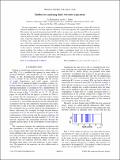Toolbox for analyzing finite two-state trajectories
Author(s)
Flomenbom, O.; Silbey, Robert J.
DownloadPhysRevE_78_066105.pdf (2.108Mb)
PUBLISHER_POLICY
Publisher Policy
Article is made available in accordance with the publisher's policy and may be subject to US copyright law. Please refer to the publisher's site for terms of use.
Terms of use
Metadata
Show full item recordAbstract
In many experiments, the aim is to deduce an underlying multisubstate on-off kinetic scheme (KS) from the statistical properties of a two-state trajectory. However, a two-state trajectory that is generated from an on-off KS contains only partial information about the KS, and so, in many cases, more than one KS can be associated with the data. We recently showed that the optimal way to solve this problem is to use canonical forms of reduced dimensions (RDs). RD forms are on-off networks with connections only between substates of different states, where the connections can have nonexponential waiting time probability density functions (WT-PDFs). In theory, only a single RD form can be associated with the data. To utilize RD forms in the analysis of the data, a RD form should be associated with the data. Here, we give a toolbox for building a RD form from a finite time, noiseless, two-state trajectory. The methods in the toolbox are based on known statistical methods in data analysis, combined with statistical methods and numerical algorithms designed specifically for the current problem. Our toolbox is self-contained—it builds a mechanism based only on the information it extracts from the data, and its implementation is fast (analyzing a 106 cycle trajectory from a 30-parameter mechanism takes a couple of hours on a PC with a 2.66 GHz processor). The toolbox is automated and is freely available for academic research upon electronic request.
Date issued
2008-12Department
Massachusetts Institute of Technology. Department of ChemistryJournal
Physical Review E
Publisher
American Physical Society
Citation
Flomenbom, O. , and R. J. Silbey. “Toolbox for analyzing finite two-state trajectories.” Physical Review E 78.6 (2008): 066105. (C) 2010 The American Physical Society.
Version: Final published version
ISSN
1550-2368
1539-3755